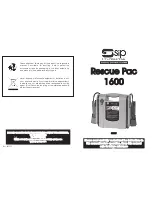
4
• Release all pressures within the system slowly. Dust and debris may be harmful.
• Do not use inflator if switch does not turn it on or off. An inflator that cannot be controlled with
the switch is dangerous and must be repaired.
• Place the switch off position before making any adjustments, changing accessories, or storing
the inflator. Such preventive safety measures reduce the risk of starting the inflator accidentally.
• Store idle inflators out of reach of children and other untrained persons. Inflators are dangerous
in the hands of untrained users.
• Check for misalignment or binding of moving parts, breakage of parts, and any other condition
that may affect the inflator’s operation. If damaged, have the inflator serviced before using. Many
accidents are caused by poorly maintained tools.
• Use only accessories that are recommended by the manufacturer for your model. Accessories
that may be suitable for one inflator may create a risk of injury when used on another inflator.
• Keep the inflator and its handle dry, clean and free from oil and grease. Always use a clean
cloth when cleaning. Never use brake fluids, gasoline, petroleum-based products, or any strong
solvents to clean your inflator. Following this rule will reduce the risk of loss of control and
deterioration of the enclosure plastic.
• Never point any inflator toward yourself or others.
• Do not exceed the pressure rating of any component in the system.
• Protect material lines and air lines from damage or puncture. Keep hose and power cord away
from sharp objects, chemical spills, oil, solvents, and wet floors.
SERVICE
• Inflator service must be performed only by qualified repair personnel. Service or maintenance
performed by unqualified personnel may result in a risk of injury.
• When servicing an inflator, use only identical replacement parts. Follow instructions in the
Maintenance section of this manual. Use of unauthorized parts or failure to follow Maintenance
instructions may create a risk of shock or injury.
SPECIFIC SAFETY RULES
• Know your inflator. Read operator’s manual carefully. Learn its applications and limitations, as
well as the specific potential hazards related to this tool. Following this rule will reduce the risk of
electric shock, fire, or serious injury.
• Risk of bursting. Do not operate inflator to result in output pressure greater than marked
maximum pressure of item to be inflated. Do not use at pressure greater than 160 PSI.
• To reduce the risk of electric shock, do not expose to rain. Store indoors.
• Inspect unit for cracks, pin holes, or other imperfections that could cause inflator to become
unsafe. Never cut or drill holes in the inflator.
• Make sure the hose is free of obstructions or snags. Entangled or snarled hoses can cause loss
of balance or footing and may become damaged.
• Use the inflator only for its intended use. Do not alter or modify the unit from the original design
or function.
• Always be aware that misuse and improper handling of this inflator can cause injury to yourself
and others.
• Never leave an inflator unattended with the air hose attached to the item being inflated.
• Do not continue to use an inflator or hose that leaks air or does not function properly.
• Always disconnect the air supply and power supply before making adjustments, servicing an
inflator, or when an inflator is not in use.
• Do not attempt to pull or carry the inflator by the hoses.
• Always follow all safety rules recommended by the manufacturer of your inflator, in addition to all
safety rules for the inflator. Following this rule will reduce the risk of serious personal injury.
• Household use only.
• Do not use inflator as a breathing device.
• Never direct a jet of compressed air toward people or animals. Take care not to blow dust and
dirt towards yourself or others. Following this rule will reduce the risk of serious injury.





































